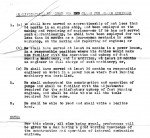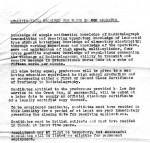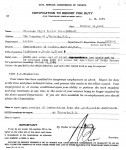– Roy Carver (son of C. E. Carver on Kains Island 1933 – 1944)

The Civil Service Commission (CSC) of Canada was a very imposing body of bureaucrats who controlled the hiring and firing of government employees. It was a bit intimidating when I applied in 1969, and from the evidence on the documents that have been given to me, it was equally, if not more so, in 1933.
Clarence Edgar Carver applied for temporary employment as a lighthouse keeper on Quatsino lighthouse (aka Kains Island) and was accepted.

In those days the equipment on a lighthouse required an engineering certificate for the operation of the Fog Alarm and a lot of beforehand experience. There was also a requirement for proficiency in Radiotelegraphy to operate the station’s Radio Beacon.
Most of the photos and information here I received from Roy Carver, son of C. E. Carver and Roy’s daughter, Sandra Vigna. Roy would have been 9 years old when he left Kains. After I wrote the paragraph above I received another email from Roy. In it he said “Clarence Edgar Carver was well qualified I’m sure for the position of a light keeper. He was one of the first Ham radio operators in Victoria; his call sign was VE5EL in Victoria, and later on Kains Island VE5RN. He had also worked on the Empress cruise ships as a radio operator going to the Orient in the 1920s. His hobby was building radios of all types.”

“Also he and his father built a couple of houses in the Victoria area.(his father, a master carpenter, worked at Yarrows Shipyards in Victoria for years building the state rooms etc. on the CPR ships, as the ships came from Great Britain with no interior work done). He was also very handy in fixing electric motors and gasoline engines. On nice days some times a fisherman would bring his boat and anchor off the island (Kains) and father would row out and make the needed repairs and would receive a nice salmon or a few crabs for his trouble.”
The engines to operate the Fog Alarm compressors were monstrous (and dangerous) and the ability of the applicant very important. More important than present day because it could take weeks to repair or replace equipment (and the keeper) because of the long distances to travel and the mode of transportation – no helicopters in those days.

The engines in the photos below are most probably Fairbanks Morse single-cylinder gas engines type “N”. According to Wikipedia they “evolved by burning kerosene in 1893, coal gas in 1905, then to semi-diesel engines in 1913 and to full diesel engines in 1924.” Roy Carver backs this up by stating “I’m pretty sure the engines ran on gasoline.”
“I may be wrong but I seem to remember the 45 gal. drums of gasoline had a red band around the middle of the drums, kerosene had a white band and the lube oil had a blue band. I’m pretty sure there were more red drums around than the others. The drums were built much heavier than to-day and were galvanized on the outside.”
[nggallery id=37]
On average there would have been at least two engines per station for the Fog Alarm (add on two more with generators if electricity was available). Roy said “I don’t ever remember any generators for electricity at Kains Island! We had no electricity except in dry cell batteries to run the radios.”1
Equipment was driven by the large leather drive belts that can be seen in the photos. These engines were probably similar to the ones described on this Fairbanks Morse page.
The engine in the Youtube video below is an FM Type N Fairbanks Morse engine, an earlier version than the ones pictured above. Turn up the volume, and imagine being in an engine room with two or more of these running! I doubt they had good hearing protection in those days. There are many more videos on Youtube showing Fairbanks Morse engines running, mostly farm equipment or generators.
[media url=”http://www.youtube.com/watch?v=JhrwHBEXXJ8&feature=related” width=”400″ height=”350″]
A lot of the keeper’s time was taken up by cleaning these engines. Most were kept shiny and spotless. Brass and bronze kept polished and paintwork cleaned of oil. The polished engine room was the pride of many a lighthouse keeper. Roy Carver’s comment was “The mention of cleaning brass reminds me that when I and later my sister were old enough, one of our Saturday chores was to polish engine room brass! Father was very fussy about keeping things clean and organized everywhere, not only the engine room, so we learned the fine art of cleaning very early!”

As a closing note, C. E. Carver became permanent keeper on Quatsino Lighthouse and stayed there for eleven years, from his appointment on November 29, 1933 to July 26, 1944 when he was transferred to Active Pass lighthouse. From that lighthouse he retired on March 30, 1948.
For more information and photos on the Fairbanks Morse engines please see the page here on this website.
*************************************
FOOTNOTES:
1Dry Cell Batteries – “In those years it wasn’t uncommon to run radios completely off

dry cell batteries. Companies that made flashlight cells also combined the cells in series to give 90 volts or so, then stuck them into a tar filled cardboard box with connectors on the top for selling. Another battery would be required for the tube filaments, typically 1 1/2 volts. Since they were dry cells, they were not rechargeable and so were discarded as they wore out. Some companies combined the two required voltages into one package. These batteries were very common at that time, especially on farms–often called farm batteries.” – Frank Statham – see his Rough Radio website – a history of wireless along the British Columbia coast.
In a later email Roy Carver mentioned that “dry cell batteries are the same as todays regular flash light batteries; you use them ’till they are dead then chuck them! They are not rechargeable! The dry cell batteries that ran the radios were about 2-1/2 ins. (6.35 cms) in diameter and about 8 ins. (20.3 cms) high with a blue cardboard wrapping with Eveready in red lettering. They were sealed with black tar on the ends and at one end had two brass clips ( plus (+) and minus (-) ) that one squeezed with two fingers, a small loop would appear, put the bare end of a wire through the loop, release the clip and the wire is connected to the battery. I’m guessing but I would say they were 1-1/2 volts each. One could bundle them up to produce the needed voltage. I remember the large wood AM receiver in the living room ran on a dry cell battery in a cardboard case. It could have been multiple dry cell batteries inside or one large dry cell, I never new. It was a sealed box with two connections on top. As I remember it looked like it was manufactured as one power pack, and they did last a long time. Mind you the radio was only on for two or three hours an evening. I remember in the early 1950’s one would see a bundle of the same batteries under the main floor in the basement of a house with a phone.”
For more information on early radio batteries there are some excellent photos of Eveready batteries on this Antique Radio page.